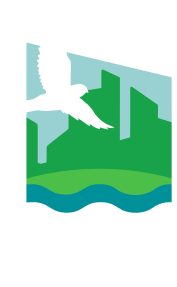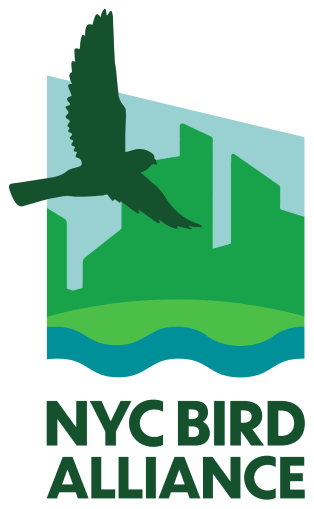Birding In NYC
Explore Birding In:
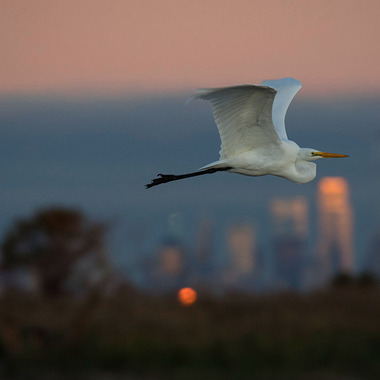
While many people may not associate New York City with wildlife or birdwatching, the truth is that in the City's parks and green spaces, and along portions of the 578-mile waterfront, you'll find some of the best places in the world to watch birds. New Yorkers need only take a bus, subway, or ferry to truly world-class birding locations in all five boroughs--including Central Park in Manhattan, Jamaica Bay Wildlife Refuge in Queens, Pelham Bay Park in the Bronx, Prospect Park in Brooklyn, and Mount Loretto Unique Area on Staten Island. Hundreds of bird species may be seen at these hot spots and many more across the city, and the variety changes constantly throughout the year.
Extraordinary birding in New York City is due to a combination of geography, topography, and habitat diversity: New York City is located at a point of concentration along the Atlantic Flyway bird migration route, and our harbor’s varied ecology provides nesting habitat for a broad array of waterbirds, raptors, songbirds, and more. For tens of thousands of years, since the end of the last ice age, birds have migrated to and through the area. Large numbers of arctic, boreal, northern temperate, and southern temperate species follow the Atlantic Flyway. On an annual basis, more than 200 different species frequent the New York City metropolitan area. Over 400 species have been recorded here, including many rarities found by passionate and determined NYC birders.
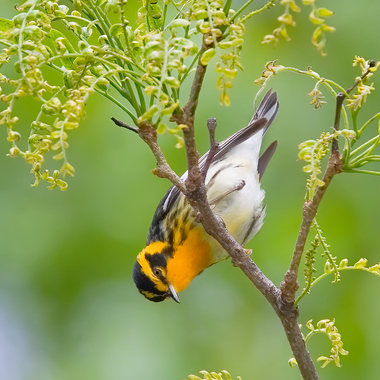
Blackburnian Warblers are highly sought after by birders, when they migrate through New York City. Photo: David Speiser
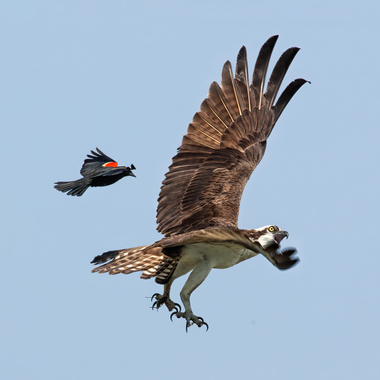
A Red-winged Blackbird harasses an Osprey that has strayed too close the smaller bird’s nesting territory. Photo: Lloyd Spitalnik
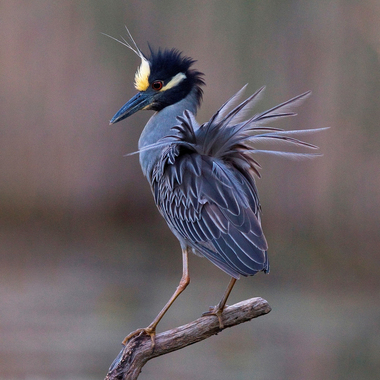
A Yellow-crowned Night-Heron raises its plumes in a spectacular breeding display. Photo: François Portmann
After a long night or day of sustained flight, birds migrating over the City alight to rest and refuel. The combination of a great number of migrants with a limited amount of open space leads birds to “funnel” into the green oases of our parks, resulting in the spectacularly dense concentrations of birds that occur during migration. A “fall out,” when large numbers of migrating birds land due to rain or storm fronts, can lead to New York City birding that birders remember for a lifetime. (This phenomenon has in recent years come to be known as the “Central Park Effect,” after the documentary film of that name created by past NYC Bird Alliance Board President Jeffrey Kimball.)
Find out the best time to bird in NYC and learn other beginning birding tips on our Birding 101 page.
View and print out a checklist of birds found in New York City (PDF).
Not quite ready to explore on your own? See our Events Calendar to find guided bird walks exploring these fantastic birding hotspots. Many are free!
All five boroughs of New York City offer an astounding concentration and diversity of birds, accessible by public transportation, bike, or on foot. With binoculars around your neck and perhaps a scope over your shoulder, you wend your way through busy streets or maneuver for a seat on the subway. You reach your birding destination, a green oasis in the urban hubbub. While you are treated to a Snowy Egret hunting for fish, a Blackburnian Warbler singing high in an Oak Tree, Black Skimmers slicing through the surf, or a Red-tailed Hawk soaring above in the sun, out of the corner of your eye you may see the Arthur Kill oil refineries, a jet on its way to Paris, or the Manhattan skyline.
Learn about all the birding gems and hotspots in New York City’s five boroughs below!
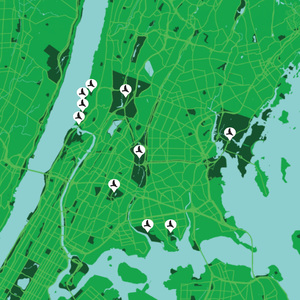
Bronx birding hotspots
BIRDING IN THE BRONX
This northernmost of New York City’s five boroughs is also one of its wildest, despite its dense population. A quarter of Bronx land is open space, and the county's woodlands, marshes, and bays attract breeding and migrating waterfowl, owls, egrets and herons, and songbirds. Two of the City’s largest public parks, Pelham Bay Park and Van Cortlandt Park, are in the Bronx, as is the beautiful New York Botanical Garden. In addition to these large preserved areas, a string of parklands stretch along the borough’s western border, the Hudson River, north to Wave Hill, while other green spaces such as Crotona Park provide important additional habitat.
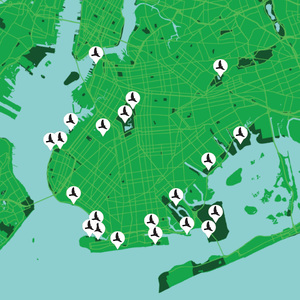
Brooklyn birding hotspots
BIRDING IN BROOKLYN
This most populous of the five boroughs is home to over 2.3 million residents, and is the second largest borough in area (81.8 square miles) after Queens. Geographically the southwestern end of Long Island, Brooklyn borders the East River, New York Bay and the Narrows, and Jamaica Bay, and its coast is dotted with rich wetland, shoreline, and grassland habitats including Coney Island Creek, Marine Park Preserve, Floyd Bennett Field, and the new Shirley Chisholm State Park. At the borough’s heart lie three landscaped parklands that are excellent migrant hotspots: Prospect Park, Brooklyn Botanic Garden, and Green-Wood Cemetery.
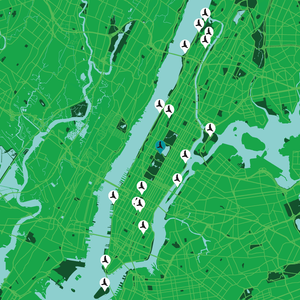
Manhattan birding hotspots
BIRDING IN MANHATTAN
Incongruous as it may seem, birding enthusiasts from all over the world visit Manhattan to go birding. In the midst of skyscrapers, concrete, and asphalt, islands of green call out to migrants passing over—Central Park, Bryant Park, Inwood Hill Park, and waterside parks from Riverside Park to The Battery. Even smaller green spaces such as Bryant Park may attract migrating, over-wintering, and resident birds. Because of the concentration of migrating birds that can occur, Central Park is considered one of the best birding spots in the northern hemisphere.
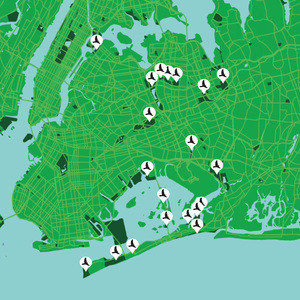
Queens birding hotspots
BIRDING IN QUEENS
Almost as large as Manhattan, the Bronx, and Staten Island combined, the borough of Queens encompasses 37 percent of New York City's total area—and contains an astounding diversity of birds to match its size. Its western and northern shorelines border the East River and Long Island Sound while its southern shores open on Jamaica Bay and the Atlantic Ocean. Two districts of the expansive Gateway National Recreation Area are in Queens: the Jamaica Bay Wildlife Refuge (shared with Brooklyn) and the Breezy Point District. Forest Park is the first in a “necklace” of green spaces stretching east across Queens, including the Kissena Park corridor and ending at Alley Pond Park.
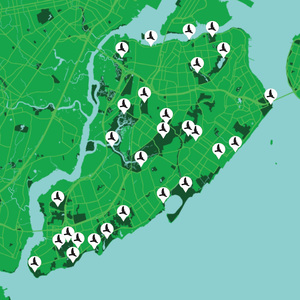
Staten Island birding hotspots
BIRDING ON STATEN ISLAND
Anchored by the wooded Staten Island Greenbelt and High Rock Park at its center, this least populated of the City’s boroughs also offers 2,000 acres of freshwater wetlands (the Staten Island Bluebelt), tidal marshlands, and 60 miles of waterfront. Birding hotspots include Great Kills Park, Wolfe's Pond Park, Mount Loretto Nature Preserve, Conference House Park, Clove Lakes Park, and the newly developed Fresh Kills Park, built upon the Freshkills Landfill and now a habitat for grassland birds such as Grasshopper Sparrow and Eastern Meadowlark. Staten Island can be reached from Manhattan by a spectacular ferry ride on Upper New York Bay past the Statue of Liberty. (Many bird species can be observed from the ferry!)
